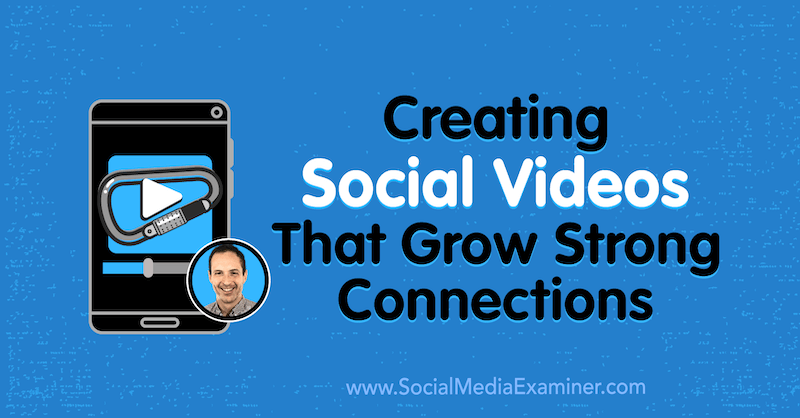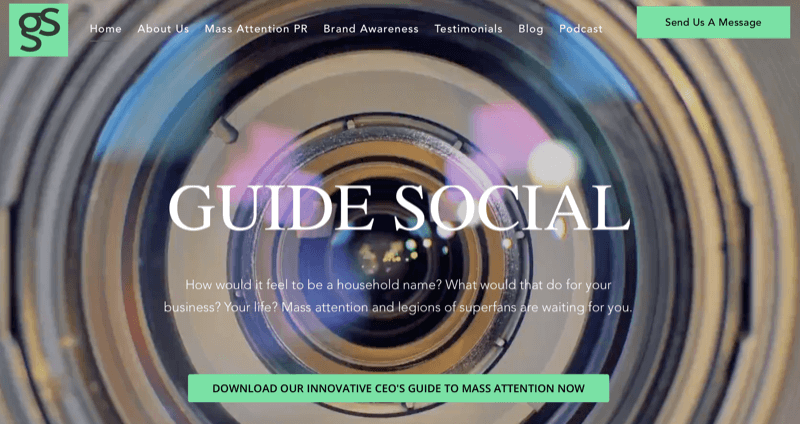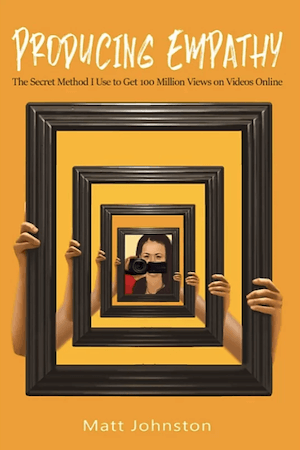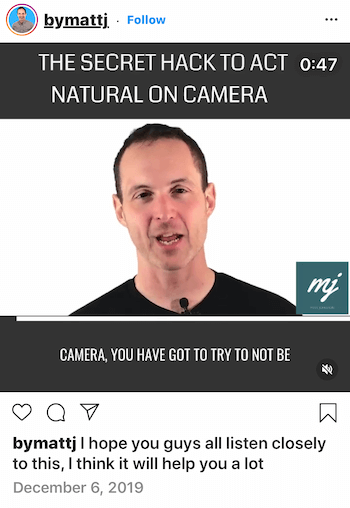In this post Michael Stelzner, CEO of Social Media Examiner, interviews Matt Johnston, founder of Guide Social and author of the book Producing Empathy. He explains how to create strong connections with your customers or prospects. Check below the article in full.
Wondering how to use video to build stronger connections with your customers and prospects? Looking for a process to follow for your next video?
To explore how to create emotional connections with video, I interview Matt Johnston on the Social Media Marketing Podcast.
Matt is a former journalist turned video marketing expert and founder of Guide Social, a video marketing agency that helps businesses get mass attention. He hosts The Video Marketing Podcast and is author of the book, Producing Empathy.
Matt shares his HERO process for creating empathy-driven video and explains how any business can use storytelling to create marketing videos people will share.
Listen to the Podcast Now
This article is sourced from the Social Media Marketing Podcast, a top marketing podcast. Listen or subscribe below.

Building Strong Connections With Video
A natural storyteller, Matt spent most of his 20s as a theater director in New York City before earning a graduate degree in journalism at Syracuse University’s Newhouse School of Public Communications. Matt then spent a few years producing TV news before becoming a digital video producer at Business Insider. He later built New York Magazine‘s digital video program from the ground up, which incorporated their other brands including Vulture and The Cut.
Next, Matt went on to build three new lifestyle channels for NowThis, the top global video news publisher on Facebook. After racking up billions of video views for NowThis Sports, NowThis Money, and NowThis Food, he left to start his own firm, Guide Social.
Guide Social is a video marketing company that creates both emotionally driven testimonial content and big, branded content campaigns for companies and personal brands. Guide Social’s videos are built around empathy-driven storytelling because empathy is what makes content go viral.

Matt aims to bring the human connection back to the world of social media marketing. At the beginning, there was a gold rush in digital marketing, with everybody flocking to the next funnel, and the personal nature of social media got lost somewhere. Matt feels like video is the conduit to bring those connections back because video is such an incredibly personal way to build a relationship with an audience.
If you’re a personal brand, video gives you the experience of really putting yourself in front of someone, face to face, literally just a few feet away. That’s a powerful connector. Great social media video is also about giving value to people in the way they want to consume it, and truly caring about what they want, need, and can use. It’s just like human-to-human relationships. Video feels more personal than other types of content.
You can build a deeper relationship with somebody using video than you often can with a blog or with any other platform online. This makes video the perfect medium to bring that empathy back and show that we’re all humans and can identify with each other’s emotions if we’re brave enough to really put ourselves out there.
It’s why Matt’s book is called Producing Empathy: People share and engage with content based on emotional identification or empathy. Being vulnerable, transparent, and valuable is the entire game. If you can force yourself to somehow break down your own walls, you’ll become known, loved, and trusted. This is where we’re trying to go, especially in social media marketing. That’s where video comes in. Being you is more powerful than being famous.

There’s a strong feeling of identification that comes with being able to see other people. Even on a podcast, you feel close to the person speaking because the experience replicates what it might be like sitting next to each other. You can get something that feels much more identifiable on video. Even in a selfie video, it feels like the person is speaking directly to you.
There’s something about looking into people’s eyes. We see ourselves in there. The eyes are a window into the soul. The audience gets just a little bit entranced and that can be a very powerful experience.
There’s also all of the nonverbal communication that happens when you look at someone’s face. The expressions of their mouth, the wrinkles on their forehead, and the way that they look away or look up and think—all of that adds a layer to the verbal communication. Those expressions convey something even in the absence of words. That’s a strong form of meta-communication, which is super-powerful.

There’s something deep that happens when you get a chance to see someone’s face. You get to see that they’re not acting; they’re being authentic and true.
The HERO System
Matt calls his system for creating social media video “HERO,” which is an acronym for hook, empathy, response, and over-deliver. It’s squarely focused on emotional identification, value, and empathy. It’s all about communicating the message, “I actually care about you; here’s the value I have to impart to you. Do you see yourself in me? If so, let’s go on this journey together.”
All of the big video programs Matt built for his previous employers were social media videos, geared toward algorithmic-based news feed platforms—which describes pretty much every social platform except potentially YouTube. The main way other social platforms differ from YouTube is in how you find video content.
On YouTube, you’re coming from a thumbnail; you’re coming from one place to another to get a video. Very often it’s based on search intent. With the algorithms, you’re just shown things. A video comes up and it’s a matter of, “Hey, here’s a gift. Are you interested or not?” You have a very limited window.
There’s also a difference in intent. When you go to Facebook, Instagram, or LinkedIn, you don’t necessarily have the explicit intent to watch video. You’re going there to get updated on your friends and your connections, and you may or may not choose to watch a video. With YouTube, you go there with the explicit intent to watch a video, and you’ll probably stick around longer on YouTube because that’s why you’re there.
On the algorithmic platforms, since we marketers are “disrupting” the user experience, we’ve got to create something that causes some sort of an emotional reaction to provide value.
The main currency Matt shoots for with social media video is the share because that’s what leads to virality. People will share content that they emotionally identify with because they want other people to emotionally identify with it too. People share content well before they watch even half of the video.
You have to optimize for the share, for the response, because that’s how you go viral. If that happens, it sends a signal that you’re creating something that people find valuable and connect with. On any of those algorithmic-based news feed platforms, we don’t go to the content—the content comes to us. We have to change the way we structure our videos to optimize for it.
H: Hook
Hook is the emotional reaction at the very beginning, the first 3 or 4 seconds of a video.
We have two sides to our brains. One side of our brain makes cognitive decisions for us such as whether we should have a ham sandwich or a turkey sandwich. We’re not talking to that side of the brain with our videos; there’s not enough time for that.
We’re trying to stop thumbs so we need to speak to the part of people’s brains that is much more connected to their bodies, to their emotions. We need to reach the nerve connections where if you touch a hot stove, you scream and run the other direction. That’s the brain that we’re looking for and we want to nail it from the beginning.
There are two ways to do that with the hook. The first way is if you have amazing footage; the best stuff gets front-loaded. Don’t wait. This is different on YouTube, because there, you need to do teases to get people more engaged in the content and send those signals to YouTube that people are watching a lot of your video.
It’s different on the algorithmic social media platforms. If you look at Facebook and Instagram engagement graphs, you’re going to see the drop-off rates plummet after 10 seconds. That’s fine because you’re reaching many more people, and you’re disrupting their experience—but if you’re putting your best stuff 30 seconds into your video, nobody’s going to see it. You have to stop them there at the very beginning.
You can put it in again later if you want because you’re telling a story the whole time. So if you can, hook them from the start with the best footage you have because that’s where the money is.
If you don’t have any great video footage, use a really good headline that’s specific and strikes an emotional chord. Think about BuzzFeed headlines; for example, “The Simple Reason Every Woman Is Curling Her Hair Wrong.” It’s so specific that every woman who curls her hair is going to empathize with that and so she’s in.
Even if I don’t have amazing footage that’s going to blow people away, I’m able to get them into the video through emotional connection instead of footage.
This text-on-screen format meets people where they are because they’re sitting on their phones, they’re often not able to listen, and you have a very short window. There’s no way that you can rely on a situation in which you’ve got no idea how they’re experiencing your content. If you just fly the text on-screen and you hit them over the head with it, then you can catch their attention. Hopefully, it’s a good-enough headline or video footage that it really cuts to their heart and makes them want to stop.
Videos almost always autoplay in people’s feeds. If you don’t stop their thumbs from the start, you’ve lost your chance to get someone into your video content. This is why the worst thing you could possibly do is start your videos with a logo. There’s nothing more important than the first 3–5 seconds because it doesn’t matter how good your video is after that. If nobody watches it, what impact does it have?
It’s the same thing as putting a boring headline on a great blog. It could be the best-written piece of content in the world, but if you can’t get people into it, you’re going to have a fundamental issue with your content creation and distribution.
E: Empathy
Emotional identification is the reason anybody clicks anything online. It blows them away or it’s going to give them value. It has the promise of connection or the promise of a relationship. We want to see ourselves, we want a mirror—that’s what we all subconsciously want when we’re looking for content online to engage with. This is a great way to think about value, because with content, you need to be squarely focused on giving value.
The best way to give value is by understanding how your audience feels and showing empathy. It’s an automatic two-way street. Empathy is an incredible process to go through with somebody and a great relationship-building piece if you can show empathy with content.
Empathy is also the best way to come up with a content strategy. What kind of content should you make? Well, what kind of things resonate with the lifestyles and lives of the people that you’re serving? What do they care about? What do they cry about? What do they laugh about?
Make sure that you’re choosing stories that will spur empathy and telling them in a way that continues to show that you emotionally identify with audience members and that they can emotionally identify with you. You’re letting them in and they’re letting you in. Then you’ll really get the opportunity to build an awesome connection with them, which can go so far from a business standpoint.
It’s not about your product and service, it’s about the people you serve. It’s not about you, it’s about them. When Matt is trying to help brands come up with the type of content to use, he takes them through what he calls a persona exercise. They come up with their ideal avatar, the ideal target customer. Then they think about that avatar’s entire lifestyle.
Many times, we see the audience only through our own very limited lens. We’re only looking at them through the lens of what we want, as if we were the only thing in their lives and the problem we solve is the only thing going on with them. Instead, we need to look at the entire lifestyle that they’re living.
Matt teaches a process called a lifestyle map. After doing the persona exercise, you make a lifestyle map where you put the avatar in the center and draw little bicycle spokes out. Each spoke is a different piece of that person’s lifestyle.
Let’s say we’re selling wedding dresses. We have our avatar, Sylvia, in the middle, and she’s getting married. The different bicycle spokes would be the different parts of Sylvia’s life. Is Sylvia’s life all about getting married? No. There’s a lot going on in Sylvia’s life and that’s what surrounds our avatar.
Depending on your product or service, your avatar could be a high-income individual who is extremely busy so we know that there are a lot of people in that avatar set who are lawyers and doctors. “Extremely busy” would be one core lifestyle trait.
Then we’d go down again and say, “Well, most of the people in this avatar set are moms.” So we would have “mother” as another spoke for Sylvia. Over here, we say that this avatar is mostly 30- to 35-year-old women. We can go around all of the things that matter to Sylvia, what she cares about in her life.
And then, as someone who sells wedding gowns, we can make content about motherhood, we can make content about busy lifestyles and issues with morning routines, and all of the things that make Sylvia say, “Oh yes, that’s me. Yes, I do have a problem with that.” It builds a relationship.
It’s got nothing to do with wedding gowns. That’s the part that a lot of marketers are going to struggle to grasp. It’s got everything to do with the challenges faced by the audience they’re trying to attract, and whether those videos resonate with that audience.
The key is creating a deeper relationship with that human being. Often, as marketers, we’re not playing an AOV, or average order value, game, which is, “I want you to buy something now and then go away.” We’re playing an LTV, a lifetime value, game. We want to create superfans. And you don’t create a super-fan by saying, “Hey, buy my wedding gown.”
Social media is becoming more personal and it’s going into private channels more often. It’s more important than ever to deepen those individual relationships.
R: Response
Response is where the share happens. If you’re just creating content for people to consume, it’s going to be one-way and it’s probably not going to go viral. It could provide value but it’s not quite structured correctly. When you’re trying to get someone to emotionally respond to your content, this is where we structure stories in completely different ways.
The basic idea is to continue to front-load different parts of the story to create those cold opens so we can get the share in before we even get to the story.
Very often, when you’re structuring a social video script, you may get to a point where you want to just deliver context. You get people in, and you offer that hook and the promise of your headline—but if you continue just setting the stage with your next line, that’s not shareable content. The important thing is to locate the biggest empathy moments in your script, the biggest mirror moments that will really make people share those things.
Don’t do the most common thing right off the bat. Find the wackiest, craziest piece and put it right up front because you’re optimizing it for response. The response is done by the watcher but it’s cued by the way you compose the video. By front-loading your video after the hook with really valuable, interesting, or emotional substance, the hope is that your audience will hit Share before they’ve even watched the rest of the video, and then they’ll keep watching it.
It’s normal to tell a profile story in a very linear way: Start at the beginning and go to the end. But if you structure your video that way, when you’re mostly trying to distribute it from social platforms, you’re not optimizing it for shares. You need to think a little bit harder and develop that cold open.
One time Matt went to Switzerland to interview Paralympic athletes for a campaign with Toyota. He interviewed a Mexican mono-skier who started crying because he admitted to Matt that he’d thought about ending his life. His guest had never told anybody, because he had the accident at 14 years old and almost lost everything, including the will to live. Matt said to himself in that moment, “This needs to be in the beginning of the video. I need to make sure that people see this and experience this. Because this is the truth. This is empathy.”
A lot of people would have built up to that moment and made it the crescendo; but instead, Matt decided to reorganize it so that it was more of a cold open. He used it to get people feeling something for this man and going with him on this journey to move into it.
O: Over-Deliver
There’s nothing new under the sun with content. We’re all usually making the same stories. So you’ve got to exceed people’s expectations of value in that content because that’s what they’re going to remember.
The goal with any piece of content is to get it shared. But when it’s done, when people have consumed it, did they feel like they had at least one useful nugget they could take away from it that they hadn’t heard or experienced before?
How can you over-deliver value to show that you actually care? How do you show that you’re not just cookie-cutting these videos, you’re putting thought into them, you’re putting heart into them, and you care about the people who see them? You want to help them.
You know how you feel when somebody over-delivers for you in real life? They send you a card and you think, “Oh my gosh, I can’t believe this person took the time to send me a card in the physical mail.” You also feel slightly indebted, of course, so there’s a marketing tactic there. But also you feel a connection: “Wow, this person really cares about me.”
It makes you think about yourself and reflect on yourself. In video form, by over-delivering value, you’re showing that this isn’t just a marketing tactic; it’s actually us caring about you and your experience.
These are short videos so you’ve got a lot to do in only 60 seconds. The hook is 3-5 seconds, then the first most shareable piece of information, the second most shareable piece of information, a little bit of context, and then add that extra layer of value to over-deliver again.
There’s that factor, that little way to give perspective to it that nobody else would do. Historical perspective, maybe a quote from someone tracing it back to something, a different application of this knowledge, that little extra… It’s just a couple of lines, but it really makes a difference.
Key Takeaways From This Episode:
- Find out more about Matt and Guide Social on his website.
- Listen to The Video Marketing Podcast.
- Follow Matt on LinkedIn, Twitter, and YouTube.
- Read Producing Empathy (special deal for SME readers/listeners!).
- Sign up for the Social Media Marketing Society.
- Watch exclusive content and original videos from Social Media Examiner on YouTube.
- Watch our weekly Social Media Marketing Talk Show, live on Fridays at 10 AM Pacific on Crowdcast.




